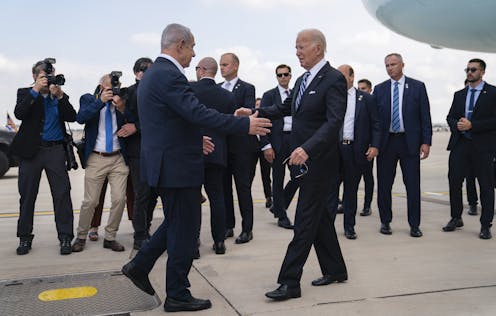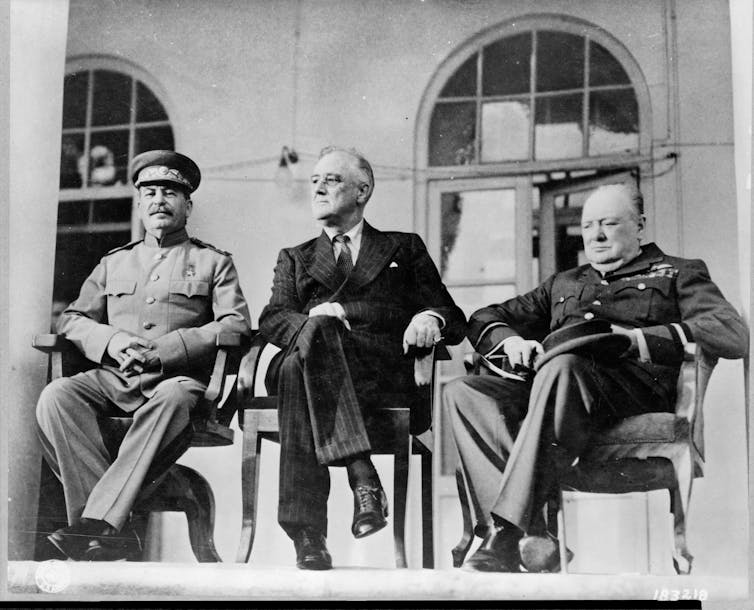Biden’s Middle East trip has messages for both global and domestic audiences
Until 1906, no US president had ever traveled abroad in office. Then Teddy Roosevelt demonstrated the power of showing up.

Even before his arrival in Israel, U.S. President Joe Biden’s decision to travel to an active war zone and the scene of an unfolding humanitarian crisis spoke volumes.
The White House has stated that Biden’s purpose is to “demonstrate his steadfast support for Israel” after Hamas’ “brutal terrorist attack” on Oct. 7, 2023. But Israel wasn’t meant to be his only stop.
The president was also scheduled to travel to Amman, Jordan, to meet with Jordanian King Abdullah II, Egyptian President Abdel Fattah el-Sisi and Palestinian President Mahmoud Abbas. However, the meeting was canceled with Biden already en route to Israel.
The trip is a bold but risky move, a carefully orchestrated display of Biden’s belief that the United States should take an active leadership role in global affairs. It is a strategy Biden has used before, most notably in his February 2023 surprise visit to Ukraine.
As a scholar of U.S. presidential rhetoric and political communication, I have spent the past decade studying how chief executives use their international travels to reach audiences at home and abroad. I see clear parallels between Biden’s trip and similar actions by other presidents to extend American influence on the world stage.

A paramount duty
Prior to 1906, no U.S. president had ever traveled abroad while in office. A long-standing tradition held that the U.S. had left the trappings of monarchy behind, and that it was much more appropriate for chief executives to travel domestically, where Americans lived and worked.
President Theodore Roosevelt, who had an expansive view of presidential power, bemoaned what he called this “ironclad custom” and ultimately bucked it. In November 1906, Roosevelt visited the Panama Canal Zone and posed at the controls of a giant steam shovel to shore up public support for constructing the canal. Beyond pushing this megaproject forward, the trip enabled Roosevelt to see and be seen on the international stage.
Other presidents followed suit as the U.S. began to take a more active role in global affairs. Just before Woodrow Wilson departed for the 1919 Paris Peace Conference at Versailles, where world leaders convened to set the terms for peace after World War I, he stated in his annual message to Congress that it was his “paramount duty to go” and participate in negotiations that were of “transcendent importance both to us and to the rest of the world.”
During World War II, President Franklin Delano Roosevelt embraced this idea of bearing a moral responsibility to speak to, and for, both U.S. citizens and a global audience. Images of FDR seated between British Prime Minister Winston Churchill and Soviet leader Josef Stalin at Tehran and Yalta symbolized global leadership – a robust vision that endured after the U.S. president’s untimely death.

Embodying US foreign policy
Going global quickly became a deliberate rhetorical strategy during the Cold War, as presidents from Harry Truman to Ronald Reagan used trips abroad to symbolize American commitment to important places and regions. By choosing to visit certain destinations, presidents made clear that these places were important to the U.S.
This is exactly what Biden no doubt hopes to accomplish through his visit to Israel. When he condemned the Hamas attack on Israel as “an act of sheer evil,” he also declared: “We stand with Israel.” Traveling to an active war zone embodies this pledge far more clearly than words alone.
And this is how Israelis have interpreted the visit. Tzachi Hanegbi, the leader of Israel’s National Security Council, described the visit as “a bear hug, a large rapid bear hug to the Israelis in the south, to all Israelis, and to every Jew.”
Addressing both sides
But Biden must also acknowledge the very real plight of Palestinians who are trapped in dire conditions in Gaza as Israel prepares for a ground invasion. This is no doubt the reason his team sought a face-to-face meeting with Abbas.
I expect that Biden will demonstrate U.S. support for Israel while also drawing a clear distinction between Hamas and the Palestinian people. And Biden will likely draw on his friendship of many years with Israeli Prime Minister Benjamin Netanyahu to urge moderation in Israel’s military response.
The home audience
Biden’s trip also has important meaning for U.S. electoral politics. A former chair of the Senate Foreign Relations Committee, Biden has long maintained that the U.S. must take an active role in the world. In the 2020 presidential campaign, he argued that Donald Trump’s policy of “America First” had left “America alone” by undercutting relationships with critical U.S. allies.
For Jewish voters, the president’s visit offers tangible evidence of an enduring U.S. commitment to Israel, especially after some far-left Democratic lawmakers refused to criticize the Hamas attack. And Biden’s willingness to condemn Hamas as a “terrorist organization” may also speak to Republican voters, who are much more likely to back Israel.
Defining an appropriate role for the U.S. in world affairs is certain to be an important issue in the 2024 presidential election, especially with active conflicts in Ukraine and now in the Middle East. Biden has consistently called for U.S. engagement abroad – not only in words, but by showing up in places like Kiev and Tel Aviv.
Allison M. Prasch does not work for, consult, own shares in or receive funding from any company or organisation that would benefit from this article, and has disclosed no relevant affiliations beyond their academic appointment.
Read These Next
The Bible says little about Jesus’ childhood – but that didn’t stop medieval Christians from enjoyin
Legends about Jesus’ early years that circulated in medieval Europe often drew on apocryphal texts.
Sleep problems and depression can be a vicious cycle, especially during pregnancy − here’s why it’s
Inadequate sleep can have negative downstream effects on everyday cognitive functioning and mental health,…
Whether Netflix or Paramount buys Warner Bros., entertainment oligopolies are back – bigger and mor
Hollywood has seen this movie before.






